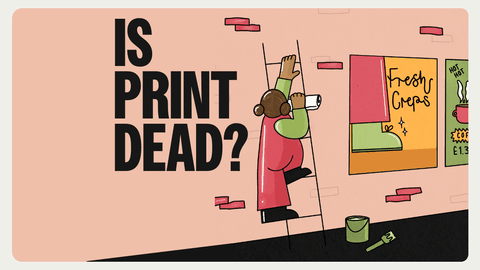NEWS ALERT - We won a SILVER IPM award for Best use of Social Media, 2025! Read more🏆

With the dazzle of digital screens and the buzz of online interactions often being a top priority for many businesses, print advertising sometimes gets left behind. However, we’re here to explain to you how print advertising is still very relevant in this digital age.
Print advertising, in the form of newspapers, magazines, brochures, and posters, has been a cornerstone of marketing for centuries. As we navigate the complexities of the digital age, it's worth pausing to appreciate the enduring power of print in conveying messages, telling stories, and captivating audiences.
In this blog, we will delve into the enduring relevance of print advertising, exploring why it matters in the digital age. From the distinct advantages it brings to the delicate ways it complements digital strategies, we'll uncover the enduring power of print in capturing attention and driving brand engagement. So, let's turn the pages and explore the timeless allure of print advertising in the contemporary marketing landscape.
Firstly let’s take a look into what print advertising is and what forms it can come in.
Print advertising refers to the use of printed media to communicate promotional messages and brand information. This traditional form of advertising encompasses a wide range of tangible materials, from newspapers and magazines to direct mail and outdoor displays. Even in our digital-centric era, print advertising persists as a tangible and impactful way for brands to connect with their audience.
Print advertising can be traced back to ancient civilizations, the Egyptians used papyrus to make sales messages and wall posters. However, if we look at print advertising in the way we remember it, the roots of print advertising can be traced back to the advent of the printing press in the 15th century. With the ability to mass-produce written materials, advertising found a new medium to reach wider audiences. However, some may argue that the first piece of print advertising in Britain was the small Caxton item of c. 1947. It was print advertisement at its simplest, just some simple text, later the ability to read and to be seen at a distance became more important elements to posters.

Over the centuries, newspapers, magazines, and various printed materials became fertile grounds for businesses to showcase their products and services. Iconic print campaigns, like Lord Kitchener Wants You or Coca-Cola's timeless ads. These campaigns have left an undeniable mark on the history of advertising.

Print advertising possesses distinct characteristics that set it apart in the marketing world. Unlike digital counterparts, print materials offer a material and tactile experience. From the feel of a glossy magazine page to the crispness of a well-designed brochure, print provides a sensory engagement that resonates with the audience. The durability of print materials also contributes to their enduring impact, as they can be revisited and shared over time.
Print advertising manifests in various forms, each tailored to different contexts and audience preferences. Newspapers and magazines host display ads and classifieds, while brochures and flyers serve as effective tools for direct marketing. Posters and printed advertising boards make a bold statement in outdoor spaces, capturing attention with compelling visuals. Understanding the diverse types of print advertisements allows marketers to choose the medium that aligns best with their communication goals.
Print advertising can be done in a variety of ways, but each brand will have different goals for each campaign. We’ve put together a few tips to keep in mind when producing print advertisements to ensure it is effective.
Effective print advertising hinges on well-executed design principles that capture attention and communicate the brand message clearly. Considerations like layout, typography, and colour schemes play a crucial role in creating visually appealing and impactful print ads. Striking a balance between aesthetics and informativeness ensures that the audience is not only attracted to the ad but also understands the key message effortlessly.
While design is essential, the words used in a print ad are equally critical. Crafting compelling copy involves creating concise yet persuasive messaging that resonates with the target audience. The language should be tailored to evoke emotions, highlight unique selling points, and prompt action. Whether it's a headline, tagline, or body copy, every word should contribute to the overall effectiveness of the print advertisement.
Overall you want to ensure your design is eye-catching and make people stop to look and read it. It needs to be unique and offer an exciting experience to be effective. We recently produced some cool outboard advertising for our client Natures Menu, where we had bright and powerful designs painted on the sides of buildings in the heart of London, find out more here.

As technology has progressed and we spend more time looking at screens, the continued significance of print advertising may seem surprising. However, print holds a unique place in the marketing landscape. Tangible and tactile, print materials offer a sensory experience that digital mediums often lack. This physicality creates a lasting impression, fostering a connection between the brand and the audience. For example, many luxury brands or housing developers still offer brochures so you have something physical to take away on the day. All of the information you need isn’t hidden on the web, it's in the palm of your hands, which for some brands will be really important to their target audience, whereas for others having the information easily accessible online will be more beneficial. Print advertising and its effectiveness will always come down to what the brand is offering and who its target market is.
Every day we are bombarded by online ads, and the enduring nature of a well-crafted print advertisement can become a breath of fresh air. So next time you’re thinking about producing a marketing campaign why not take a look into whether print advertising could be an option for your brand?
Now we’ve discussed what print advertising is, how to produce it effectively and how it can work for your brand let's take a look at some advantages of using print.
One of the distinct advantages of print advertising lies in its tangible nature. The physical presence of a print ad, whether in a magazine, newspaper, or brochure, provides a tactile experience for the audience. Readers can feel the texture of the paper, enhancing their engagement with the content. This tangible aspect contributes to the credibility of the message. Consumers often perceive print materials as more trustworthy, establishing a sense of legitimacy and authority for the advertised products or services.
Print advertising offers a targeted approach to reaching specific audiences. Magazines, newspapers, and other print publications often cater to niche markets or particular demographics. Advertisers can strategically place their print materials in publications that align with their target audience's interests and preferences (or on the side of buildings to target passers-by, like we did for Natures Menu). This precision targeting enhances the effectiveness of the ad campaign, ensuring that the message reaches those most likely to be interested in the offering.
Printed materials have a lasting presence that extends beyond the initial publication. Unlike digital ads that may disappear from a screen with a click, print advertisements can linger in homes, offices, or public spaces for an extended period. Magazines may be kept for future reference, and posters or printed advertising boards can be displayed for weeks or even months. This longevity contributes to the prolonged exposure of the brand message, reinforcing brand recall and making a more enduring impact on the audience.
Understanding how to use print advertising alongside your digital campaign is crucial to the success of the campaign. Let’s talk about how to use print advertising in the current digital world.
Maintaining visual consistency across different platforms is crucial for brand recognition. Print advertising can play a pivotal role in this strategy by aligning its visual elements with the brand's overall digital identity. Consistent use of colours, logos, and design elements in both print and digital materials creates a unified brand image. This ensures that consumers experience a cohesive and recognisable brand presence, whether they encounter the brand online or in print.
Print advertising can seamlessly bridge the gap between the physical and digital worlds by incorporating digital calls to action. Including QR codes, personalised URLs, or social media handles in print materials encourages readers to take the next step online. This interactive element not only enhances engagement but also provides a measurable way to track the effectiveness of the print campaign. Consumers can easily transition from the printed page to a website or social media platform with a simple scan or click.
Advancements in technology have introduced interactive print technologies that bring a new dimension to traditional print materials. Augmented reality (AR) features, for example, can be embedded in print ads to create immersive and interactive experiences. Readers can use their smartphones or tablets to unlock additional content, videos, or 3D elements related to the advertised products. These interactive features add a layer of engagement that goes beyond the static nature of traditional print.
By ensuring visual consistency, integrating digital calls-to-action, and exploring interactive print technologies, brands can leverage the unique advantages of print in the dynamic landscape of digital marketing.
Print advertising, though a traditional medium, still stands strong in the digital age. Its tangible benefits, credibility, and targeted approach make it a valuable asset to any campaign that can incorporate it. The synergy between print and digital is key, ensuring comprehensive marketing coverage. Looking forward, print's future lies in strategic integration and adapting to the evolving marketing landscape. In essence, print advertising remains timeless, providing a lasting and engaging connection with audiences, that delivers an impact rarely achievable through digital platforms.